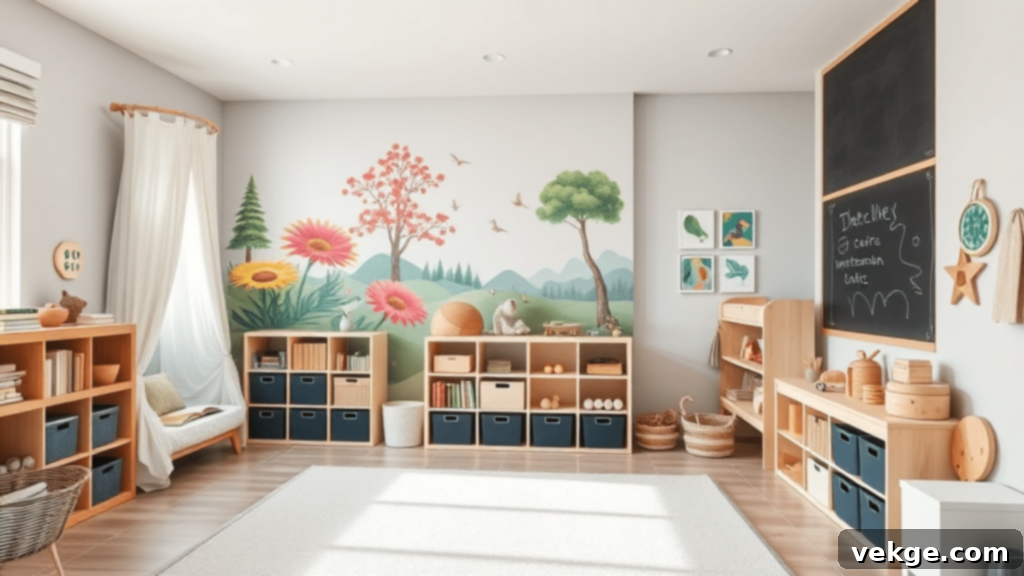Unlock Imagination: 15 Inspiring & Practical Playroom Ideas for Kids of All Ages
Every parent dreams of creating a dedicated space where their children can thrive, imagine, and learn. A well-designed playroom is more than just a room for toys; it’s a dynamic environment that fosters creativity, encourages independent play, and provides a safe haven for exploration. In today’s fast-paced world, crafting a functional and inspiring play space for your kids is an investment in their development and your family’s harmony.
Gone are the days when a playroom was merely a dumping ground for clutter. Modern playroom design emphasizes thoughtful layouts, engaging themes, and smart storage solutions that cater to both children’s boundless energy and parents’ need for organization. Whether you have a dedicated room or a small corner, transforming it into a vibrant play zone is easier than you think.
We’ve curated 15 amazing, SEO-friendly playroom ideas that strike the perfect balance between fun for kids and practicality for parents. From serene Montessori-inspired setups to bright, energetic zones, you’ll discover diverse styles to match your home’s aesthetic and your child’s personality. The best part? Each idea comes with practical DIY instructions, empowering you to bring these designs to life without a professional decorator.
Are you ready to turn a simple room into a magical kingdom, an imaginative studio, or a cozy reading retreat? Let’s dive into these incredible children’s playroom concepts that promise smiles, laughter, and endless hours of joyful discovery in any home!
1. The Minimalist Montessori Playroom: Fostering Independent Play and Focus
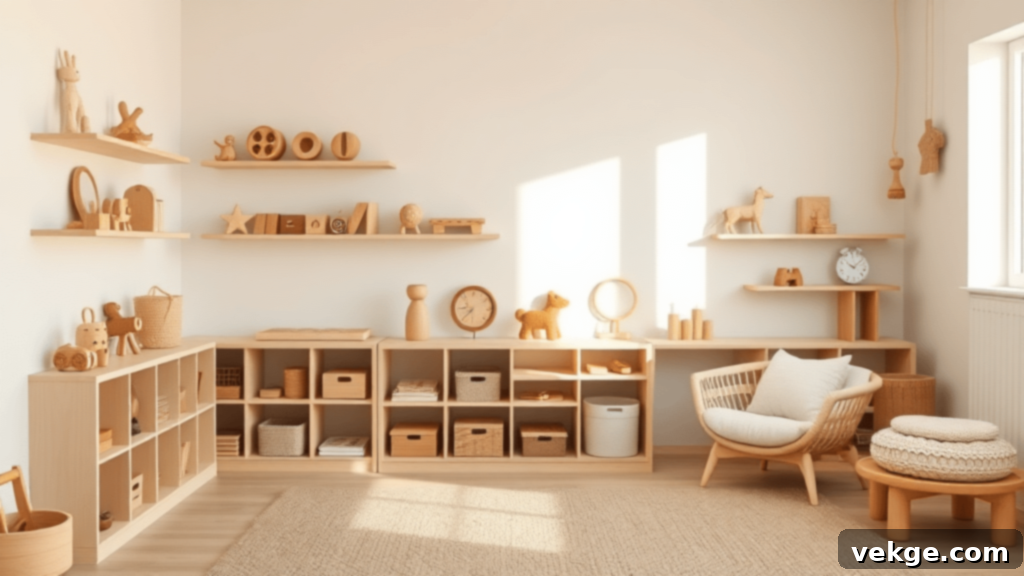
Inspired by the Montessori philosophy, this playroom concept empowers young children by allowing them to learn and explore at their own pace. A clutter-free, organized environment with accessible materials fosters self-reliance and concentration. Kids thrive when they can independently select activities and move freely, which builds confidence and encourages extended periods of purposeful play. This serene space, often featuring natural wooden materials and calm colors, helps little ones focus without overstimulation.
DIY Instructions: Crafting Your Montessori-Inspired Play Zone
- Choose a Calm Color Palette: Opt for whites, warm beiges, or light grays on walls, complemented by natural wood tones for furniture, creating a tranquil backdrop.
- Install Open, Child-Height Shelving: Use sturdy open shelves (like IKEA Kallax) or custom floating shelves mounted at your child’s eye level for easy access to learning materials.
- Incorporate Natural Fiber Rugs: Add soft rugs made from jute, wool, or cotton to define play zones and provide a comfortable, non-toxic surface for floor activities.
- Implement a Thoughtful Toy Rotation System: Limit the number of visible toys to high-quality, open-ended educational items. Store the rest and rotate them regularly to maintain engagement and prevent clutter.
2. The Whimsical Mural Playroom: Where Walls Tell a Story
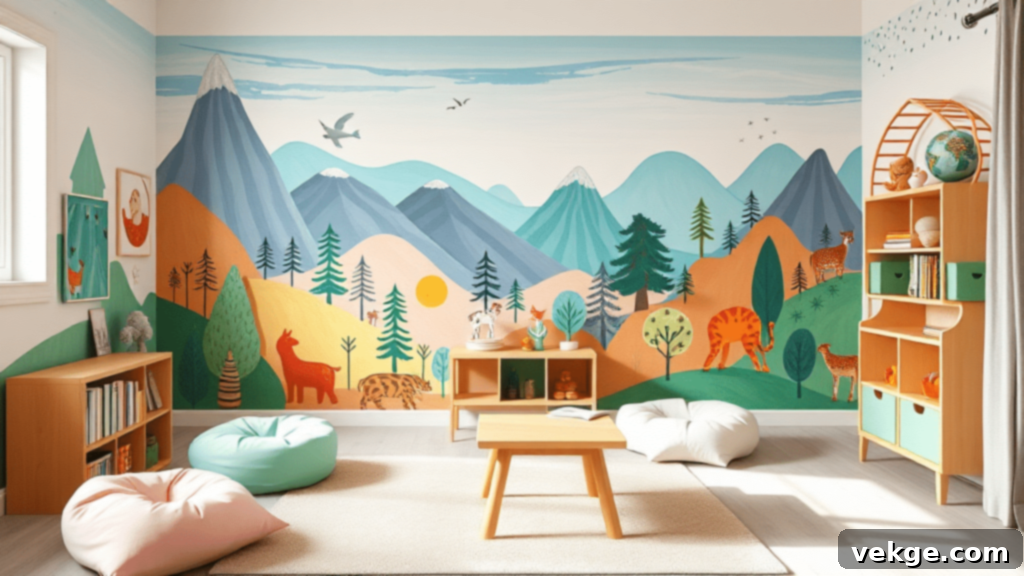
Transform plain walls into a captivating backdrop that sparks endless imagination! A vibrant mural can turn your playroom into an enchanted forest, a starry galaxy, or a bustling cityscape, inviting your children to become part of the story. This dynamic visual stimulus encourages creative storytelling, pretend play, and helps develop narrative skills. It’s a powerful way to bring a room to life and provide a constant source of wonder and inspiration for your little adventurers.
DIY Instructions: Bringing Walls to Life with Imagination
- Pick a Captivating Theme: Decide on a theme that resonates with your child, such as nature, space, a jungle adventure, or even abstract patterns.
- Use Stencils or Project a Design: For intricate designs, use large stencils or project an image onto the wall to trace before painting, ensuring accuracy and ease.
- Choose Non-Toxic, Washable Paints: Prioritize safety with VOC-free, non-toxic paints that are also washable, making it easy to clean up any accidental marks.
- Add Texture with Stickers or 3D Elements: Enhance the mural with wall decals, foam cutouts, glow-in-the-dark accents, or even small shelves integrated into the design for added depth and interactivity.
3. The Chic Neutral Playroom: Sophistication Meets Child-Friendly Design
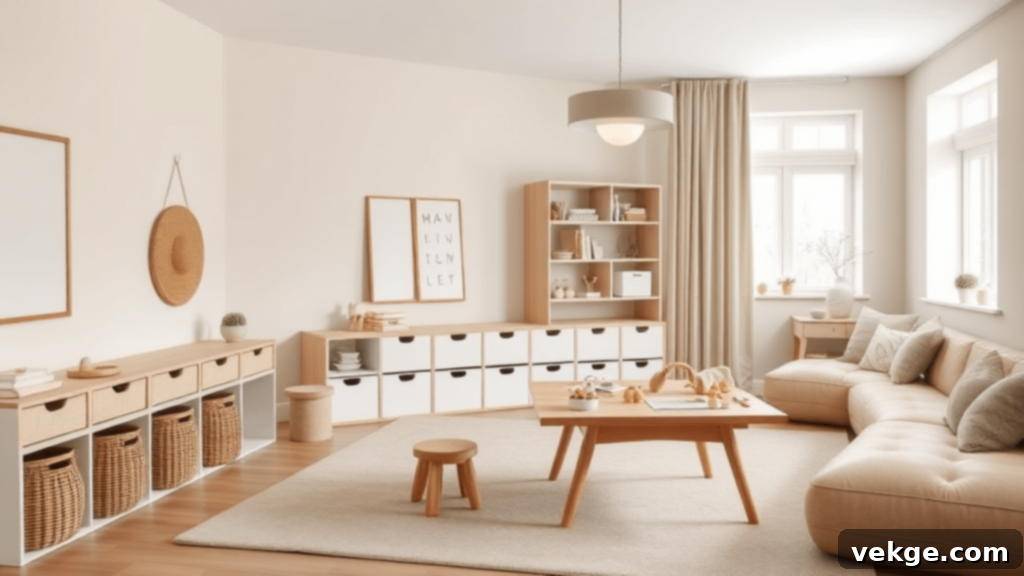
Create a calm and cohesive play space that seamlessly blends with your home’s sophisticated aesthetic. Soft beige, warm white, and muted grey tones establish a peaceful atmosphere where toys and artwork can truly shine without overwhelming the senses. The beauty of a chic neutral playroom is its timeless appeal; it grows gracefully with your children, adapting from toddler play to a tween hangout space with minimal adjustments. This understated elegance fosters a serene environment conducive to both focused play and relaxation.
DIY Instructions: Designing a Serene and Stylish Play Area
- Paint in Soft, Sophisticated Tones: Opt for elegant shades like sage green, warm taupe, or greige (grey-beige) to create a refined and calming backdrop.
- Utilize Stylish Storage Solutions: Choose woven baskets, sleek cubbies, or minimalist cabinets that complement the decor, keeping clutter discreetly tucked away.
- Incorporate a Statement Lighting Fixture: Elevate the room with a rattan pendant light, a modern minimalist chandelier, or elegant sconces for both function and flair.
- Add a Soft, Modular Play Couch: Invest in a versatile play couch (like a Nugget) or similar modular foam seating. It provides comfort, encourages imaginative building, and perfectly fits the chic aesthetic.
4. The Interactive Chalkboard Wall Playroom: A Giant Canvas for Creativity
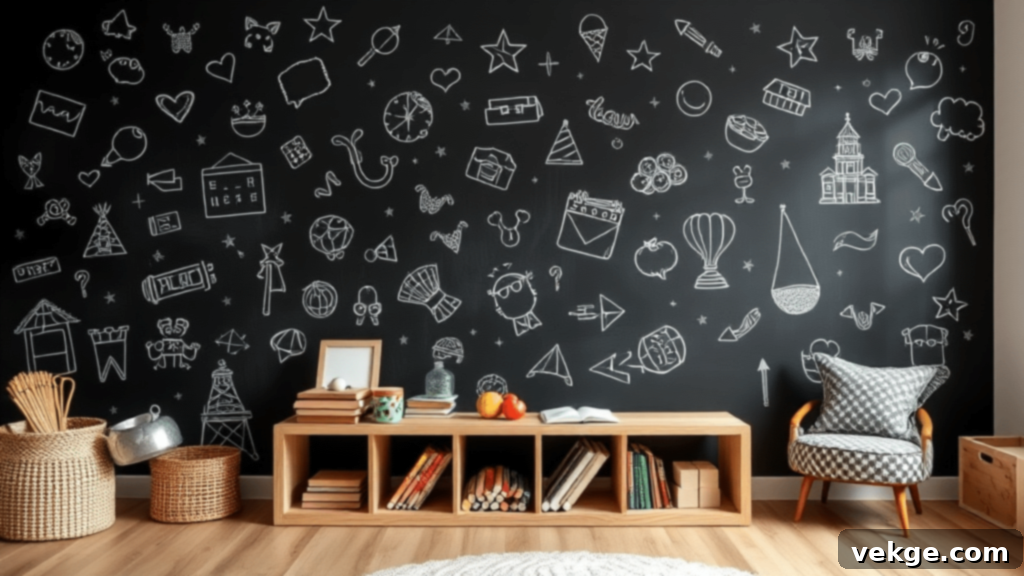
Unleash your children’s inner artists by dedicating an entire wall to their creative expression! An interactive chalkboard wall transforms into an expansive canvas where kids can draw, write, practice letters, or simply doodle to their heart’s content. This endless supply of “paper” encourages free expression, reduces paper waste, and makes cleanup incredibly simple with just a quick wipe. It’s an engaging feature that promotes fine motor skills, literacy, and boundless imagination for children of all ages.
DIY Instructions: Installing Your Own Creative Chalkboard Wall
- Choose High-Quality Chalkboard Paint: Select a durable chalkboard paint, available in classic black or green, or explore other tintable options for a customized look.
- Frame It with Wood Trim: To create a polished, defined section and protect surrounding walls, consider adding a simple wooden frame around the chalkboard area.
- Include a Convenient Supply Station: Install a small shelf or hanging caddy nearby to keep chalk, erasers, and other drawing tools organized and easily accessible.
- Encourage Daily Use and Themes: Spark engagement by occasionally writing prompts, learning challenges, or rotating drawing themes to inspire new creations every day.
5. The Vibrant Color-Pop Playroom: An Energetic Hub for Fun
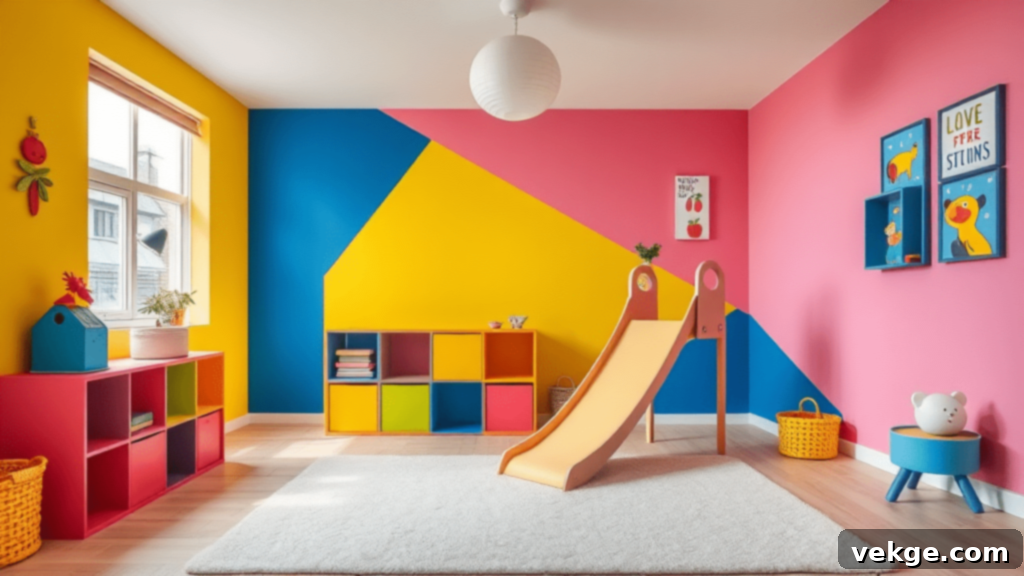
Inject joy and energy into your kids’ play area with bold splashes of color! Bright yellows, spirited reds, and lively blues ignite creativity and make the room feel exceptionally special and exciting. These vibrant hues stimulate visual development and encourage enthusiastic playtime. Mix in playful patterns, unique shapes, and fun textures, and watch how this cheerful and energetic space becomes a beloved hub for imagination, active games, and joyful discovery. It’s a design that’s all about celebrating childhood exuberance.
DIY Instructions: Creating a Burst of Color and Joy
- Pick a Signature Bright Color: Choose one or two dominant vibrant colors, such as sunny yellow, electric blue, or coral, to serve as the main accents.
- Use Dynamic Color-Blocking Techniques: Apply color strategically by painting half-walls, geometric patterns, or bold stripes to add a modern and playful touch.
- Mix & Match Playful Furniture: Incorporate fun, colorful pieces like bean bags, brightly hued cubbies, or even neon-inspired lights to amplify the lively atmosphere.
- Incorporate Interactive Decor: Add oversized wall decals of numbers or alphabets, graphic prints, or colorful string lights to further engage and delight young minds.
6. The Cozy Reading Nook Playroom: A Sanctuary for Stories
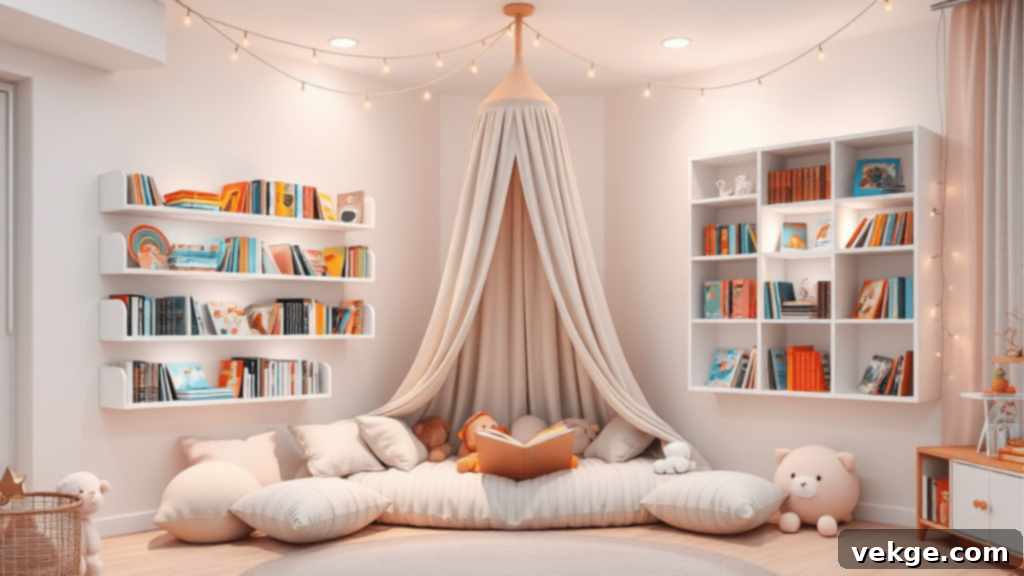
Create a magical, quiet escape where stories come to life and imaginations can wander. A cozy reading nook is a sanctuary dedicated to literacy and relaxation, complete with plush pillows, a soft rug, and easily accessible books. This inviting corner encourages a love for reading from an early age, offering a perfect spot for snuggles, independent exploration of books, or winding down before bedtime. It’s a space designed for comfort and connection, fostering a lifelong appreciation for learning and storytelling.
DIY Instructions: Building Your Child’s Literary Retreat
- Design a Reading Tent or Teepee: Construct a simple tent or teepee using light muslin or cotton fabric. This creates an immediate sense of intimacy and adventure.
- Install Floating Book Ledges: Mount narrow floating shelves at child height, displaying books with their covers facing forward to entice little readers and make selections easy.
- Add Plush Seating Options: Furnish the nook with comfortable bean bags, oversized floor cushions, or even a whimsical hanging chair to maximize comfort and appeal.
- Use Twinkle Lights or Soft Lamps: Enhance the cozy ambiance with warm LED twinkle lights, a child-safe nightlight, or a soft, dimmable lamp for evening reading.
7. The Storage-Focused Playroom: Tidy Spaces for Happy Faces
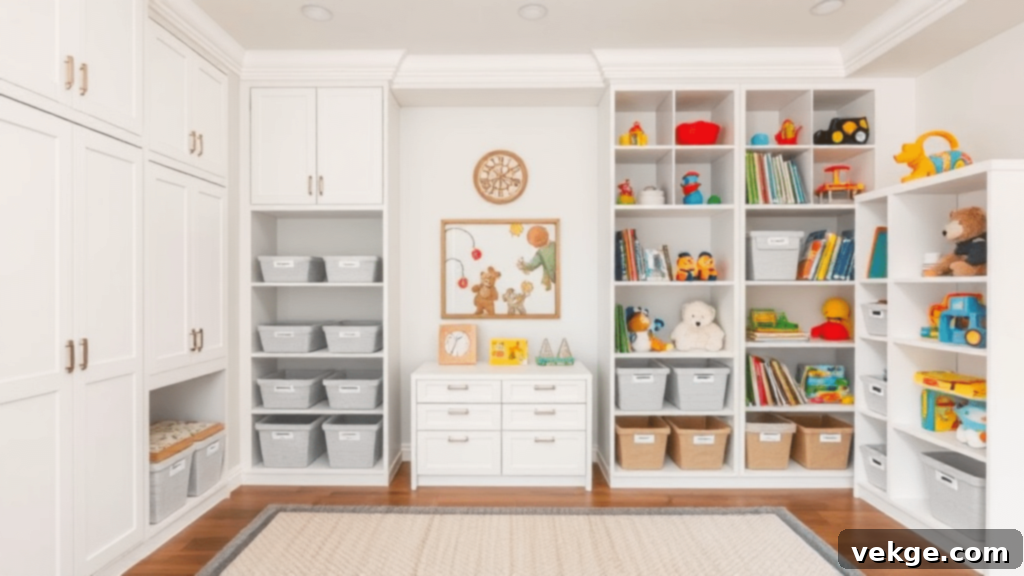
Say goodbye to clutter and hello to effortless organization! A storage-focused playroom prioritizes smart, accessible solutions that keep toys easy to find and quick to clean up. With an abundance of bins, labels, and shelves, children learn valuable organizational skills and independence as they can easily put things back in their designated spots. This design ensures less mess and more productive playtime, giving parents peace of mind and children a functional, enjoyable environment where everything has a home.
DIY Instructions: Maximizing Organization and Minimizing Mess
- Utilize Built-In Cabinets and Shelving: Incorporate custom built-ins or modular wrap-around storage solutions that blend seamlessly with the room’s design, providing ample space.
- Include Clear Bins with Picture Labels: Use clear plastic bins so contents are visible, and add picture labels (especially for non-readers) to make cleanup intuitive and fun for kids.
- Create a Strategic Toy Rotation System: Store less-used toys in high-storage areas or a separate closet. Rotate a fresh selection into the main playroom regularly to keep things interesting and manage clutter.
- Incorporate a Bench with Hidden Storage: Add a versatile storage bench that offers both comfortable seating and discreet hidden compartments for larger toys or seasonal items.
8. The Nature-Inspired Playroom: Bringing the Outdoors In
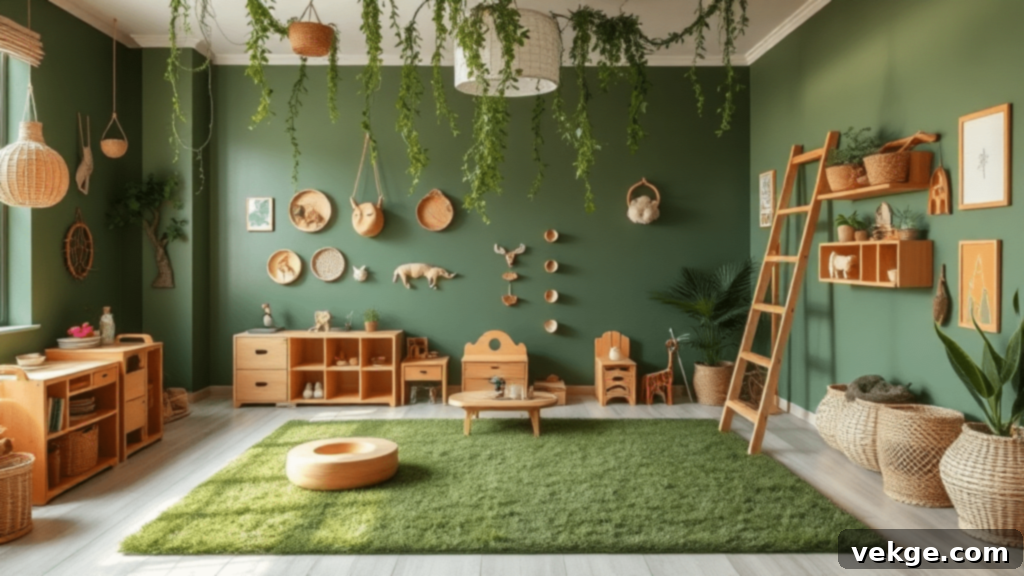
Infuse your playroom with the calming and stimulating elements of the natural world. This design incorporates organic materials, earthy color palettes, and botanical accents to create a serene yet engaging environment. Natural wood furniture, real or faux plants, and prints of animals or landscapes connect children to nature, fostering a sense of peace and wonder. The gentle, green setting is perfect for both active imaginative play and quiet moments of reflection, promoting a sense of well-being and a love for the environment.
DIY Instructions: Cultivating a Natural Haven
- Use Green and Earthy Hues: Paint walls in soothing shades of sage green, soft terracotta, or warm browns to mimic outdoor landscapes.
- Add Nature Prints or Textures: Decorate with wall decals featuring trees or leaves, incorporate wooden toys and furniture, and choose rugs with natural patterns or textures.
- Introduce a Faux Grass Rug: Lay down a soft faux grass rug to instantly create the feeling of playing outdoors, adding a playful and tactile element.
- Hang a Canopy with Hanging Vines: Install a simple fabric canopy above a play area and drape faux vines or string lights to create an enchanting, forest-like atmosphere.
9. The Multi-Activity Playroom: Zones for Every Interest
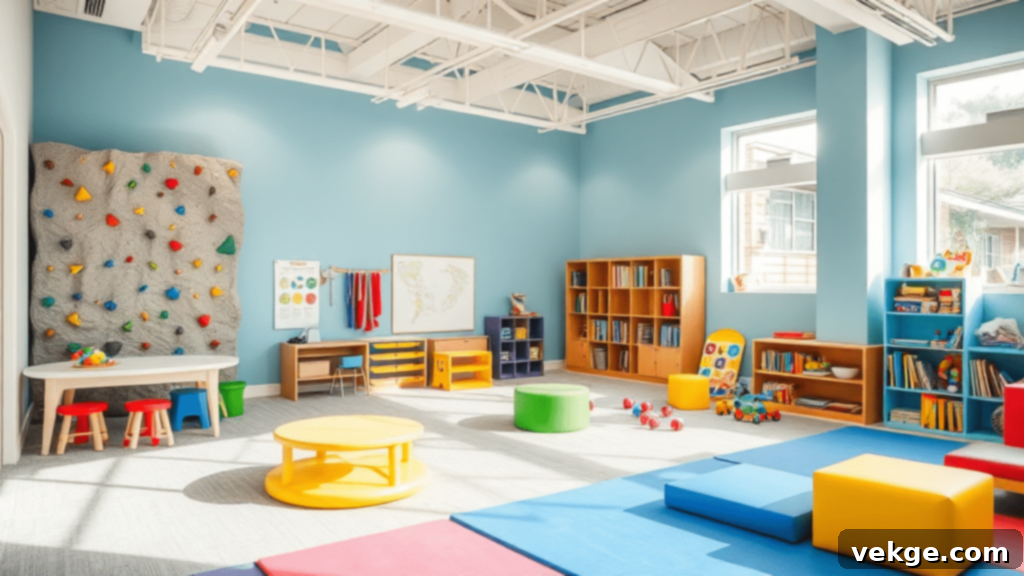
Design a dynamic playroom with distinct zones that cater to various interests, ensuring endless engagement for your children. From a dedicated craft table for artistic endeavors to a cozy block corner for budding architects and a vibrant dress-up area for imaginative role-playing, this setup allows kids to seamlessly switch between activities. This approach keeps children stimulated, encourages diverse skill development, and helps them follow their individual passions without boredom setting in. It’s an ideal solution for siblings with different interests or for maximizing fun in one versatile space.
DIY Instructions: Designing Diverse Play Zones
- Divide the Room into Clear Zones: Use furniture, rugs, or even tape on the floor to define areas for reading, arts and crafts, active play, and imaginative games.
- Use Modular Mats for Flexibility: Lay down interlocking foam tiles in active zones for comfort and safety. Their modular nature allows for easy rearrangement as needs change.
- Create a Compact Rock-Climbing Corner: Install small, child-friendly climbing grips on a reinforced section of the wall to add an exciting active play element.
- Add a Mini Sports or Movement Area: Incorporate a low basketball hoop, a soft play ball pit, or a tumble mat for gross motor skill development and energy release.
10. The Tech-Integrated Playroom: Smart Fun for Modern Kids
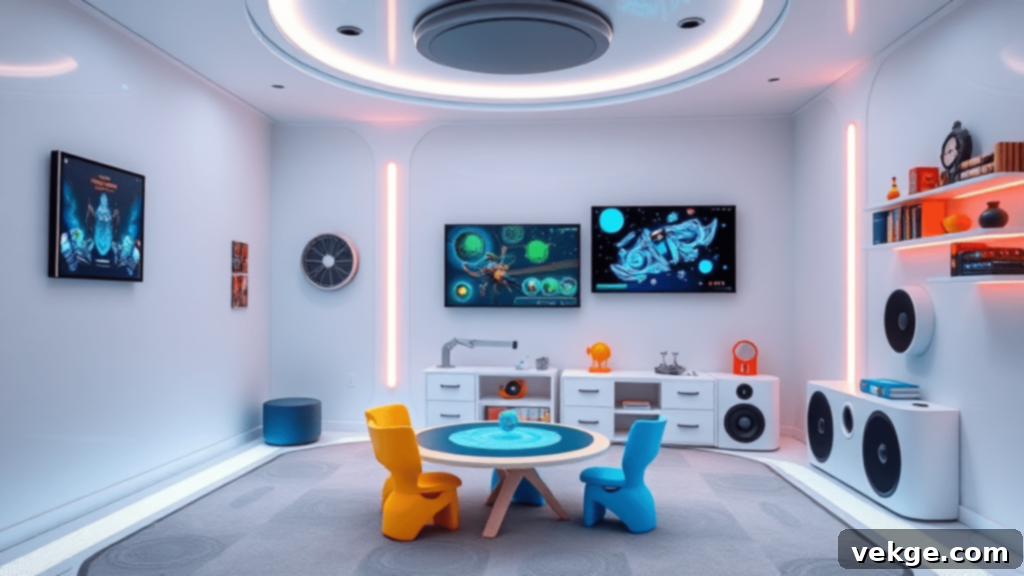
Blend the excitement of play with the benefits of modern technology in a tech-integrated playroom. This space thoughtfully incorporates smart gadgets designed for kids, offering engaging ways to learn and grow. A dedicated tablet corner with educational apps, light-up coding blocks, or interactive music tools can introduce children to STEM concepts and creative arts in a fun, accessible way. It’s about leveraging technology responsibly to enhance learning, problem-solving skills, and digital literacy, ensuring kids acquire valuable skills while enjoying their playtime.
DIY Instructions: Merging Play and Digital Learning
- Install a Secure Wall-Mounted Tablet Station: Mount a tablet holder at a comfortable, child-friendly height, ensuring a secure and hands-free experience for educational games.
- Integrate Smart Lighting Systems: Use dimmable, color-changing LED lights that can be controlled via an app, creating different moods and interactive light play.
- Add an Interactive Music or Audiobook Corner: Set up a Bluetooth speaker or kid-friendly headphones for listening to audiobooks, educational podcasts, or music, enriching auditory experiences.
- Include Educational Apps and Games: Curate a selection of STEM-focused digital tools, coding games, and creative apps that align with your child’s age and developmental stage.
11. The Scandinavian-Inspired Playroom: Simple Elegance and Functional Design
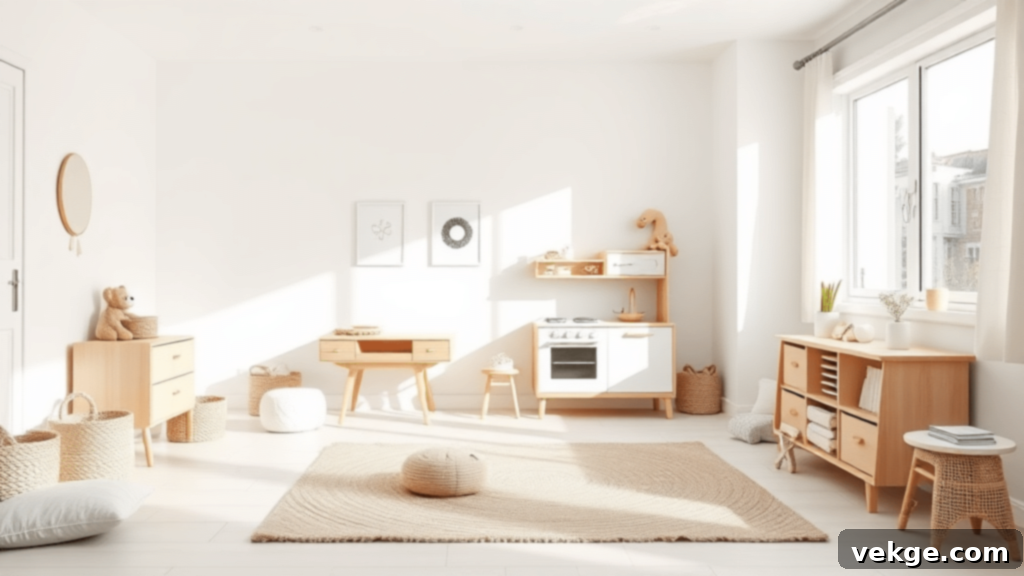
Embrace the beauty of simplicity with a Scandinavian-inspired playroom, characterized by clean lines, light colors, and natural materials. White walls paired with warm wood tones (like birch or pine) create an open, airy, and calm environment that encourages focus and creative play. This minimalist aesthetic not only looks chic but also promotes an organized space where every toy has its place, making it easy for little ones to find, use, and put away their belongings. It’s a serene design that fosters a sense of order and tranquility.
DIY Instructions: Crafting a Nordic-Chic Play Space
- Choose a Light & Bright Palette: Keep walls white or off-white, and introduce pastel accents through textiles or select decor items for subtle pops of color.
- Opt for Natural Wooden Elements: Furnish the room with light-colored wooden pieces, such as birch or pine play tables, shelves, and toy bins, for a cohesive look.
- Include a Low-Profile Play Table and Chairs: Select child-friendly furniture designed at a height that allows easy access for drawing, crafting, and tabletop games.
- Use Textured Rugs and Soft Furnishings: Layer the space with cozy sheepskin throws, chunky knit blankets, and geometric patterned rugs to add warmth and tactile interest.
12. The Arts & Crafts Studio Playroom: Unleash the Inner Artist
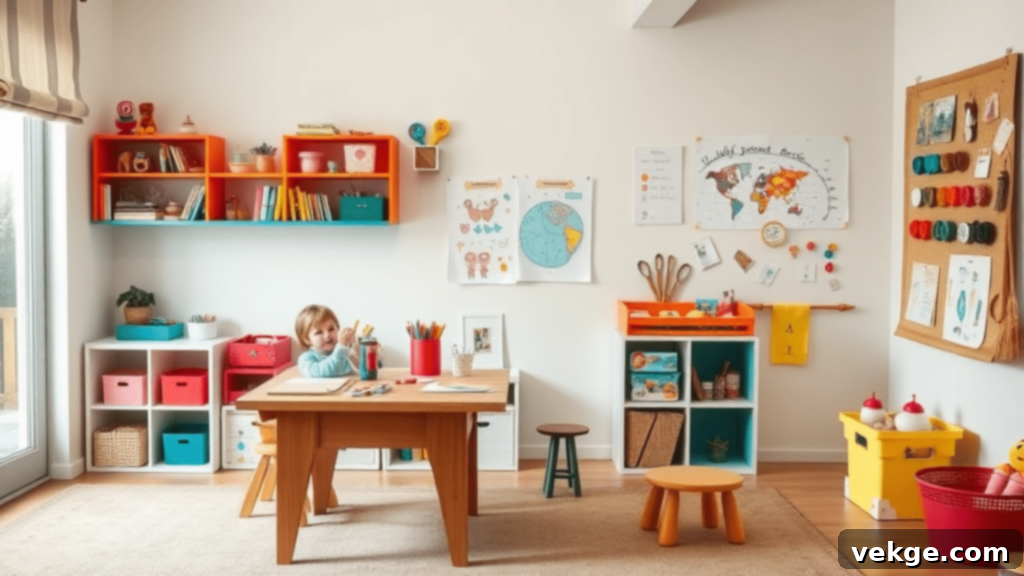
Dedicate a vibrant corner or an entire room to your children’s artistic passions with an inspiring arts & crafts studio. Featuring an easy-to-clean table, readily accessible art supplies, and a designated wall to proudly display masterpieces, this space makes creative exploration enjoyable and mess-contained. The best part for parents? Paint spills, glitter explosions, and crayon marks are confined to one area, preventing them from spreading throughout the house! This setup encourages fine motor skills, color recognition, and limitless self-expression.
DIY Instructions: Setting Up Your Child’s Creative Hub
- Designate a Wall for Art Display: Install clipboards, cork boards, magnetic strips, or a simple wire line with clothespins to showcase your child’s latest creations.
- Add a Sturdy, Easy-to-Clean Craft Table: Choose a durable table with a laminate or sealed wooden surface that can withstand paint, glue, and general creative chaos.
- Install Accessible Floating Bins for Supplies: Mount open bins or shelves on the wall to keep paints, brushes, paper, markers, and other craft essentials organized and within reach.
- Incorporate a Washable Rug or Floor Mat: Place a large, washable rug or a protective floor mat underneath the craft table for easy cleanup of inevitable spills and drips.
13. The Adventure-Themed Playroom: A World of Exploration Awaits
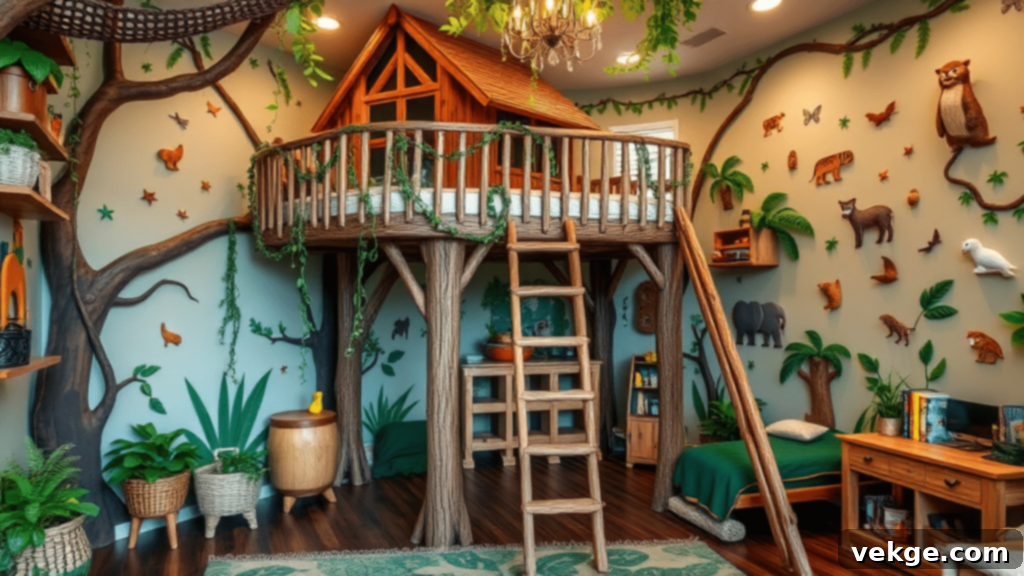
Transform playtime into an epic journey with an adventure-themed playroom! Whether it’s a jungle expedition, a space mission, or a pirate treasure hunt, this design fuels imaginative make-believe stories. Incorporate elements like a cozy fort, a child-friendly climbing wall, or a puppet stage to encourage dramatic play and storytelling. Children will spend hours concocting elaborate games and narratives in their special, immersive world, developing creativity, problem-solving skills, and social interaction through role-playing. It’s an exciting escape where every day is a new quest.
DIY Instructions: Building Your Child’s Epic Quest Zone
- Choose a Grand Adventure Theme: Select a captivating theme like a dense jungle, outer space, a swashbuckling pirate ship, or a mystical enchanted forest.
- Create a Custom Play Fort or Climbing Wall: Construct a simple wooden fort, a fabric teepee, or install child-safe climbing grips on a reinforced wall section.
- Paint a Themed Mural to Set the Scene: Bring the theme to life with a detailed mural depicting mountains, starry skies, exotic animals, or ocean waves.
- Add Fun, Immersive Props: Enhance the theme with tents, treasure chests, glow-in-the-dark stars, explorer maps, or themed dress-up costumes to spark imagination.
14. The Soft Play Sensory Room: A Safe Haven for Exploration
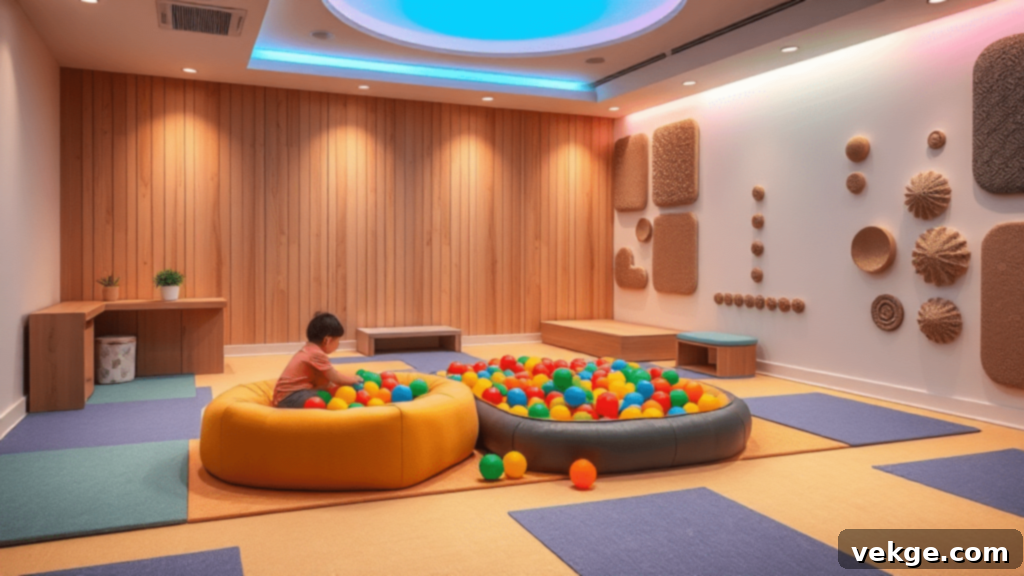
Create a comforting and stimulating environment perfect for toddlers and children who benefit from sensory exploration. This playroom features soft mats, squishy cushions, and gentle textures, providing a secure space for little ones to touch, feel, and explore at their own pace. Kids can safely roll around, build with foam blocks, or engage with various tactile elements, developing their motor skills and sensory processing in a low-stress setting. It’s a calming retreat designed to encourage quiet play, physical exploration, and emotional regulation, making it ideal for both active and sensitive children.
DIY Instructions: Designing a Calming Sensory Experience
- Use Padded Mats and Soft Play Equipment: Cover the floor entirely with soft, interlocking foam mats or gymnastics mats, and introduce soft play shapes, wedges, and blocks.
- Add a Ball Pit or Crash Pad Area: Create a dedicated section for a child-safe ball pit or a large, soft crash pad where kids can safely jump, fall, and relax.
- Incorporate Color-Changing LED Lights: Install LED strip lights or bubble tubes with color-changing capabilities to provide calming visual stimulation and alter the room’s mood.
- Install a Textured Sensory Wall: Design a wall with various textured panels, squishy elements, soft fabrics, and interactive buttons for tactile and auditory exploration.
15. The Convertible Playroom: Flexible Design for Growing Kids
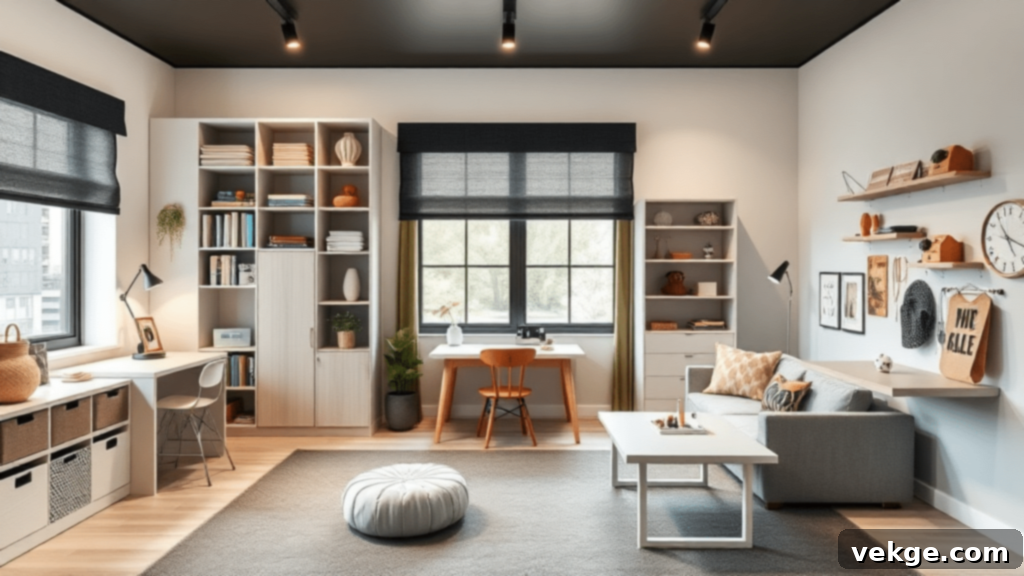
Invest in smart furniture and flexible layouts that adapt and grow with your children through every stage of development. A convertible playroom seamlessly transitions from a toddler’s building block area to a school-age child’s study spot, and eventually a teen’s hangout zone. Movable storage units, adjustable-height tables, and adaptable seating ensure the room remains functional and appealing as interests and needs evolve. This forward-thinking design maximizes your investment and minimizes the need for frequent, costly redecorations, offering a versatile space for years to come.
DIY Instructions: Crafting an Adaptable & Future-Proof Play Space
- Use Adjustable and Multi-Functional Furniture: Choose convertible desks, extendable tables, and storage units that can be rearranged or repurposed as children grow.
- Add a Wall-Mounted Foldable Play Table: Install a table that folds up against the wall when not in use, instantly freeing up floor space for different activities.
- Keep Decor Neutral and Timeless: Opt for a foundational neutral color palette and classic, versatile decor elements that can be easily updated with age-appropriate accents.
- Allow for Easy Space Reconfiguration: Prioritize lightweight, movable furniture and storage bins on wheels to enable quick and easy rearrangement of the room layout.
Maintenance & Updating the Playroom as Kids Grow
Children’s needs evolve at an astonishing pace! Thoughtful planning and simple maintenance strategies can ensure their play space remains engaging, functional, and relevant through every stage of childhood. Making small, strategic changes over time keeps the room dynamic and useful, preventing the need for costly and overwhelming complete overhauls. This approach helps you maintain a cherished space that adapts beautifully to your family’s changing lifestyle.
Adapting the Space for Different Age Groups
As your toddler blossoms into a preschooler and then a school-aged child, their interests will shift dramatically. Implement a toy rotation system: regularly swap out baby blocks and sensory toys for age-appropriate items like craft supplies, puzzles, or board games. Keep cherished items that still see a lot of love, but don’t hesitate to store away or donate items that are no longer stimulating. Involve your children in this process; they’ll feel proud and more invested in their evolving “big kid” space, learning valuable lessons about organization and decluttering along the way.
When to Transition from a Playroom to a Study Room or Teen Hangout
Pay close attention to how your children utilize the space. A key indicator for transition is when you observe them spending more time on homework, reading, or quiet individual activities than active play. At this point, gradually introduce elements that support their academic and social needs. Add a sturdy desk with ergonomic seating, invest in good task lighting, and integrate more sophisticated storage for school supplies and books. While transforming it into a study space, remember to retain some elements of comfort and fun—every student needs a break and a place to unwind! This evolution creates a versatile room that supports their growth from early childhood through adolescence.
Conclusion: Crafting Joyful Memories in a Purposeful Play Space
Creating a dedicated and inspiring play space for your children doesn’t have to be an overwhelming endeavor. The most successful playrooms are a thoughtful blend of what works practically for parents and what truly ignites joy and creativity in children. Whether you’re starting with a blank canvas or repurposing an existing room, remember that incremental changes can make a significant impact.
Begin with a manageable project, perhaps a cozy reading nook to foster literacy, or an organized art corner to encourage creative expression. Observe how your children interact with the space, what activities they gravitate towards, and what kind of environment best suits their personalities. This understanding will guide you in further enhancements.
Ultimately, there is no single “perfect” playroom design. The true essence lies in creating a flexible and loving environment where your family can make cherished memories together. The most invaluable elements are not the elaborate setups or the latest decor trends, but the unrestrained giggles, the imaginative adventures, and the shared moments of fun that unfold within those walls. Your children will carry the joy and learning from these dedicated playtimes with them long after they’ve outgrown the space, making your effort truly worthwhile.
